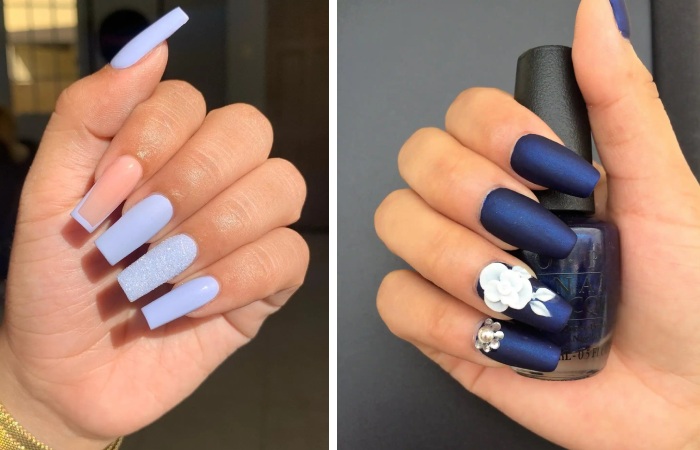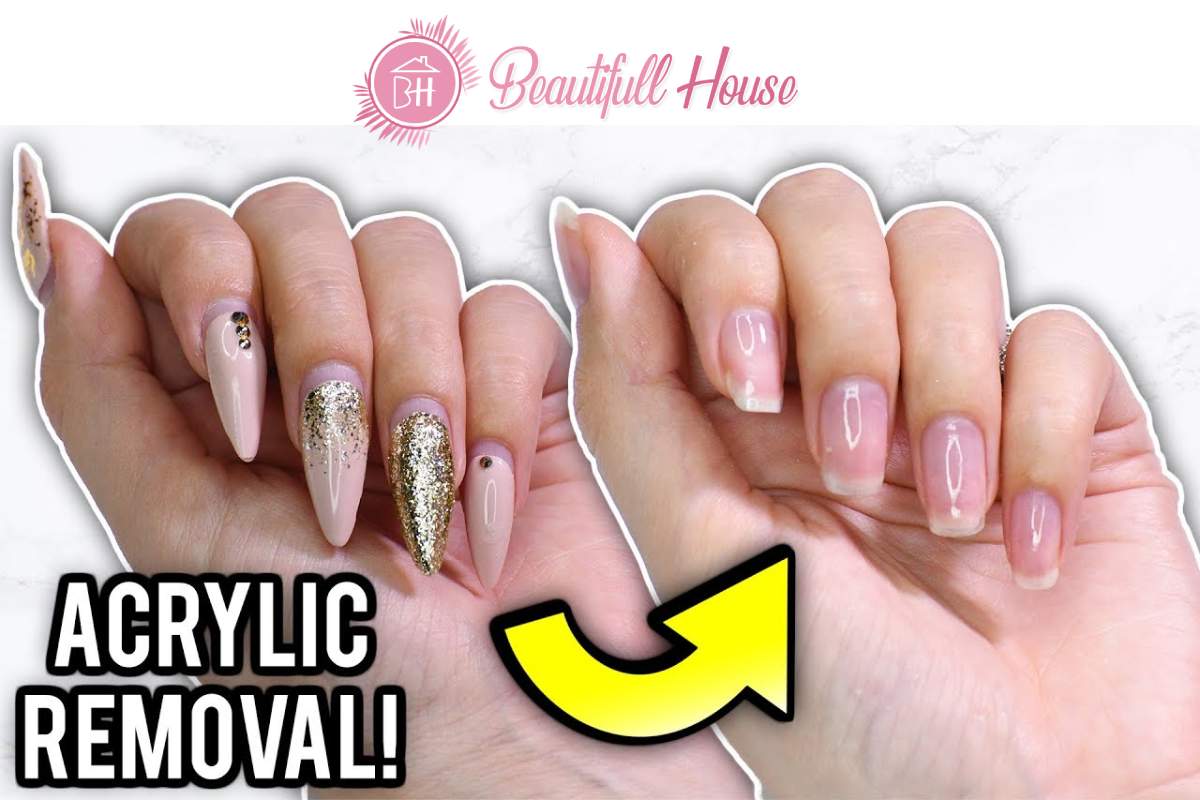Table of Contents
What are Acrylic Nails?
Acrylic nails are artificial nail developments that commonly use to create longer and more durable nails. They combine a liquid monomer (usually methyl methacrylate or ethyl methacrylate) with a powdered polymer (usually polymethyl methacrylate). When these two workings mix, they form a dough-like substance that can sculpt onto the natural nails or be applied over nail tips to create extensions.
Acrylic nails are popular for several reasons. They provide a firm surface that can withstand everyday activities and is less prone to breakage than natural nails. In addition, acrylic nails can be customized in terms of length, shape, and color, allowing individuals to achieve the desired look. They can also use to correct irregular or damaged nail surfaces.

It’s important to note that removing acrylic nails should be done carefully to avoid damage to the natural nails. It recommends having them professionally removed or following proper removal techniques using acetone and foil wraps to dissolve the acrylic.
How to Take Off Acrylic Nails Easily?
To safely remove acrylic nails, you can follow the steps below:
- Gather the necessary supplies: acetone, cotton balls or pads, aluminum foil, a nail file, a buffer, a cuticle pusher or orangewood stick, and moisturizing oil or lotion.
- Trim down the length of the acrylic nails using nail clippers or a nail file. This step will make the removal process more accessible and help reduce the risk of damage to your natural nails.
- File the surface of the acrylic nails to remove the shiny top layer. Be careful not to file too aggressively, as you want to avoid rubbing into your natural nails.
- Soak cotton balls or pads in acetone until they fully saturate. Then, place a cotton ball or pad on each of your nails, ensuring the entire nail is covered.
- Secure the cotton balls or pads by wrapping each finger with a small aluminum foil. It will help the acetone stay in contact with the acrylic nails and speed up removal.
- Leave the foil wraps on for 15-20 minutes to allow the acetone to break down the acrylic nails. You may also consider warming your hands by placing them in a bowl of warm water or using a heating pad to help accelerate the process.
- After the soaking period, gently press on the foil and cotton ball or pad to apply slight pressure and slide it off your finger. It should help remove most of the acrylic. However, do not force it if it’s still adhered to your nails. Instead, rewrap your nails and give them more time to soak.
- Once the acrylic nails have been removed, use a cuticle pusher or orangewood stick to scrape off any remaining acrylic residue gently. Again, be cautious not to damage your natural nails during this step.
- Use a nail buffer to smooth the surface of your natural nails and remove any roughness or leftover acrylic.
- After removing the acrylic nails, it’s essential to rehydrate your nails and cuticles. Next, apply moisturizing oil or lotion to nourish and replenish moisture in your nails and surrounding skin.
Remember, if you experience any discomfort or difficulty during the removal process, it’s best to consult a professional nail technician for assistance.
What should we Do After Removing Acrylic Nails?
Later removing acrylic nails, it’s essential to give your natural nails some care and attention to help them recover and restore their health.
Here are some steps to follow:
- Trim and shape your nails: Use a nail clipper or file to trim your natural nails to your desired length. Then, shape them gently with a nail file, avoiding over-filing or using excessive force.
- Buff the nail surface: Use a nail buffer to smooth the surface of your natural nails gently. It can help remove roughness or residue from acrylic nails and promote healthy nail growth.
- Moisturize your nails, then cuticles: Apply a nourishing cuticle oil or moisturizer to your nails and cuticles. It will help replenish moisture and keep them hydrated. Next, massage the oil or moisturizer in circular motions to stimulate blood circulation.
- Avoid aggressive nail treatments: Give your nails a break from any further harsh treatments, such as gel polish, acrylic overlays, or excessive filing. Instead, let them breathe and recover naturally.
- Maintaining good nail hygiene: Keep your nails clean and dry to prevent bacterial or fungal infections. Use a gentle nail brush to clean underneath your nails, and avoid using harsh chemicals or nail products that can further weaken your nails.
- Should Eat a balanced diet: A healthy diet rich in vitamins, minerals, and proteins can promote nail growth and strength. Include foods like fruits, vegetables, lean proteins, and foods high in biotin, such as eggs and nuts, in your diet.
- Be patient: It might take some time for your natural nails to recover and grow out fully. So avoid the temptation to reapply acrylic nails immediately and allow your natural nails to regain strength.
If you have any worries about the condition of your natural nails or need further advice, consider consulting a professional nail technician or a dermatologist who can deliver personalized recommendations and guidance.
How Can You Take Off or Remove Acrylic Nails Without Acetone?
If you don’t have acetone or prefer not to use it, alternative methods exist to remove acrylic nails.
Here are a few procedures you can try:
- Soaking in warm water: Fill a bowl with warm water and add a gentle, moisturizing soap or dishwashing liquid. Soak your nails into the warm soapy water for about 20-30 minutes. It helps to soften the acrylic, making it easier to remove. After soaking, gently pry off the acrylic nails using a cuticle pusher or orangewood stick. If the acrylic doesn’t come off quickly, repeat the soaking process or try another method.
- Dental floss or cotton thread method: This method is helpful if there is a small gap between the acrylic and your natural nail. Take a piece of dental floss or cotton thread, slide it under the edge of the acrylic nail, and move it back and forth in a sawing motion. It can help loosen and lift these nails. Be gentle and patient to avoid causing any damage to your natural nails.
- Nail file method: If you’re comfortable with filing, you can use a coarse nail file to file down the acrylic nails until they become thin carefully. Be cautious not to file too aggressively to avoid damaging your natural nails. Once the acrylic has filed down significantly, switch to a finer-grit file to smooth out the remaining layers. This method may take longer and requires patience.
- Seek professional assistance: If you cannot remove these nails successfully or are concerned about damaging your natural nails, it’s best to seek help from an experienced nail technician. They have the expertise and proper tools to safely remove acrylic nails without causing harm to your nails.
Remember to moisturize your nails and cuticles after removing the acrylic nails to replace moisture and promote nail health.
[how to get acrylic nails off at home]
[How to take off acrylic nails without acetone]
[how to take off acrylic nails with hot water]
[How to take off acrylic nails at home]
[how to take off acrylic nails at home with acetone]
[how to get acrylic nails off fast]
[how to remove acrylic nails at home without tools]

